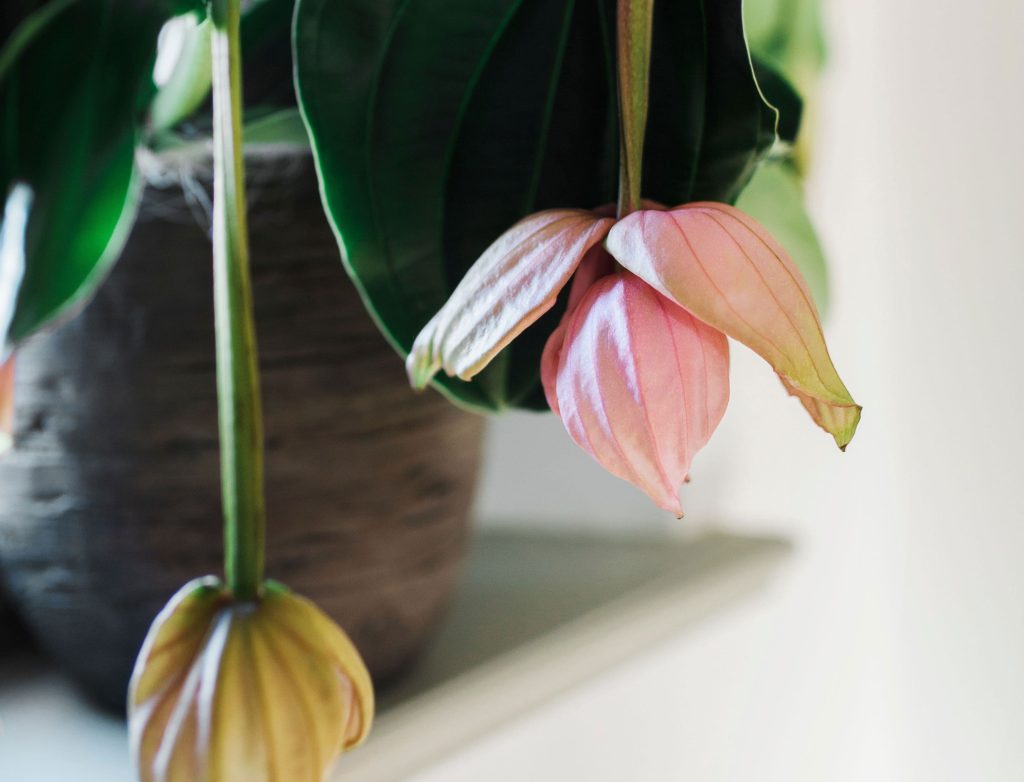The Enigmatic Beauty of the Medinilla: Unveiling the Secrets of Nature

Little is known about the mysterious medinilla plant. Popularly known as the “orchid of Malaysia,” this captivating evergreen shrub with unusual flowers is neither Malaysian nor an orchid. Let’s debunk its first two lies right away. Native to Java and the Philippines, this rare tropical plant grows in its natural habitat as an epiphyte — a characteristic it shares with orchids — meaning it grows without soil. Perched several meters above solid ground, the medinilla roots itself in hollow stems and crevices filled with detritus on the bark of trees, climbing towards the light in the humid and shady forests of the islands in the western Pacific. In these lush tropical and subtropical jungles, more than 300 different species of medinilla have been cataloged, with varieties reaching the size of shrubs with rough cork-like skin and twisted stems over three meters tall. The aptly named Magnificent Medinilla (Medinilla magnifica) is the most commonly cultivated in pots and available for domestic life in nurseries outside its habitat. It’s the only one we can enjoy in person more than 12,000 kilometers away from its place of origin.
The Striking Appearance of the Medinilla Magnifica
What catches the eye the first time one comes face to face with a Medinilla magnifica are its hanging, pendulous stems, which bear clusters of beautiful pink flowers downwards. It’s striking — much like when we, from a Western perspective, glance at a manga or a haiku book — this growth direction contrary to our logic. Similar to its distant relatives, orchids, the natural position of the medinilla’s flower spikes is pendant. And here’s the third lie: the striking buds hanging in cascades are not flowers but bracts. These are organs formed from modified leaves, different from the standard leaves that some species have. This botanical structure emerges around the flowers to protect them, like a shawl or an umbrella. Although there are green bracts, exceptionally, these curious leaves have other shades. Like with the poinsettia (Euphorbia pulcherrima), bougainvillea (Bougainvillea), or hydrangeas (Hydrangeas), the medinilla’s bracts are of an unusual color for a leaf, visually resembling flower petals.
The Spectacular Color Palette of the Medinilla
The Pantone of the medinilla is enough to drive any fan of Greta Gerwig’s Barbie crazy. From pastel pink to fuchsia, passing through a decadent old pink and shades ranging from coral to cooler mauve tones, the monochromatic refinement is one of the great spectacles of this plant. Once a year, in spring, among the standard leaves — evergreen, thick, shiny dark green, flexible like leather — pink stems emerge, growing up to 20 or 30 centimeters and bearing pendant pink leaves that remain closed for months, like a capsule. When they finally open, the bracts reveal the true flowers. These are inflorescences or clusters composed of small grouped flowers resembling a cluster, giving rise to another of the medinilla’s nicknames: the pink grape. They bloom in summer and remain on the plant for a long time, sometimes for more than four or five months.
Good Vibrations: A Unique Reproduction Mechanism
The unique condition of its flowers explains another curious behavior of the wild medinilla related to its reproduction mechanism: trapped in tiny sacs at the end of the stamens, pollen is released thanks to the buzzing of pollinators, which manage to make the pollen dust come off with the vibration of their bodies and their frantic fluttering.
Growing Medinilla: Tips from Experts
As a decorative specimen, in Spain’s climate, “the medinilla grows well in a pot, indoors, in a very bright place, but protected from direct sunlight,” explains Yolanda López, from Floristería Jardín in Madrid. “It likes humidity or frequent spraying, and moderate watering when the substrate is dry, avoiding roots becoming waterlogged. In warm regions, it can thrive outdoors, although in cold areas it needs to be sheltered in winter,” advises the expert.
In its native Philippines, the medinilla is called Kapa-kapa, which translates from Tagalog as gauze or mantle, perhaps referring to the leaves that cover the flower. Candelabra tree, tropical hydrangea, and pink grape are among the other names by which this plant is known for its three lies of which little or almost nothing is known, but it has much to tell. Its surname, magnifica, gives an idea of its grandeur.
By unraveling the mysteries of the medinilla, we delve deeper into the wonders of nature, discovering the intricacies and beauty hidden within.
